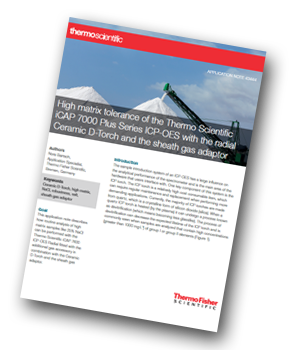Thermo Fisher Scientific has produced an application note demonstrating how routine analysis of high matrix samples such as 25% NaCl can be performed with the Thermo Scientific iCAP 7400 ICP-OES Radial fitted with the additional gas accessory in combination with the Ceramic D-Torch and the sheath gas adaptor.
 Introduction
Introduction
The sample introduction system of an ICP-OES has a large influence on the analytical performance of the spectrometer and is the main area of the hardware that users interface with. One key component of this system is the ICP torch. The ICP torch is a relatively high cost consumable item, which can require regular maintenance and replacement when performing more demanding applications. Currently, the majority of ICP torches are made from quartz, which is a crystalline form of silicon dioxide (silica). When a quartz ICP torch is heated (by the plasma) it can undergo a process known as devitrification (which means becoming less glasslike). The process of devitrification can decrease the expected lifetime of the ICP torch and is commonly seen when samples are analysed that contain high concentrations (greater than 1000 mg·L-1) of group I or group I Goal I elements. To overcome these problems the Ceramic D-Torch was developed.
Instrumentation
The analysis of salt-containing samples is a challenge for ICP-OES. For this analysis the iCAP 7400 ICP-OES Radial fitted with the additional gas accessory was used with a sample introduction kit. The radial system was chosen because of its high matrix tolerance and its ability to optimize the radial viewing height. The optimization of the radial viewing height helps to reduce spectral interferences.
Sample Preparation
High matrix blank, calibration standards and stability solutions were prepared from single element solutions (1000 mg·L-1, SPEX CertiPrep Group, Metuchen, US). The individual solutions were made with 18 MΩ ultra-pure water and trace metal grade nitric acid (67-69%, Fisher Chemical, Loughborough, UK) as well as common table salt, to a final concentration of 25% NaCl as well as 0.2% HNO3. All solutions were spiked with 10 mg·L-1 yttrium (1000 mg·L-1, SPEX CertiPrep).
Results
The linearity of the calibration curves is very good with correlation coefficients greater than 0.999 for each wavelength. Recoveries of the spiked samples are within a range of 97–104%. The 10 hour long-term stability data also show recoveries within the range of 95–105%. The method detection limits (MDL) for most elements are in the single digit μg·L-1 range or lower.
Conclusion
The Thermo Scientific iCAP 7400 ICP-OES Radial fitted with the additional gas accessory used in conjunction with the Ceramic D-Torch, baffled spray chamber, the Burgener Mira Mist Nebulizer and the sheath gas adaptor allows for ultimate high solids tolerance. Moreover, very good spike recoveries indicate that an internal standard is capable of correcting for physical interferences induced by this complex sample matrix.
